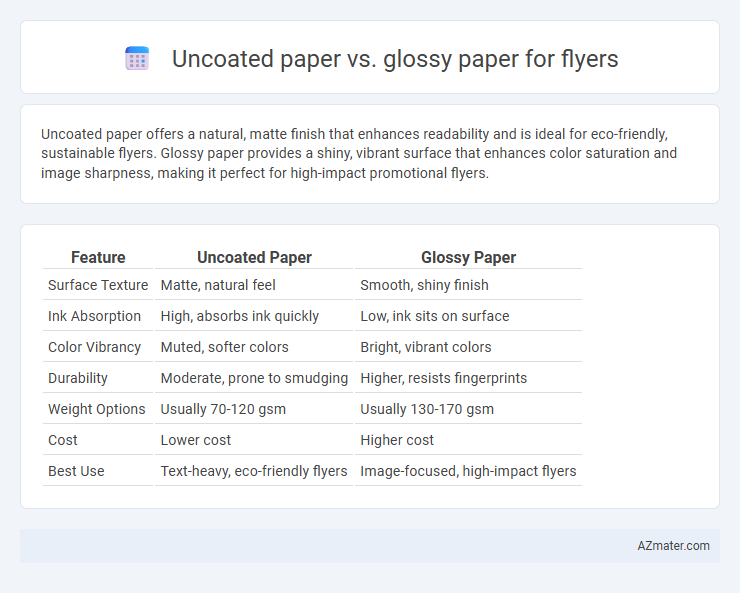Uncoated paper offers a natural, matte finish that enhances readability and is ideal for eco-friendly, sustainable flyers. Glossy paper provides a shiny, vibrant surface that enhances color saturation and image sharpness, making it perfect for high-impact promotional flyers.
Table of Comparison
| Feature | Uncoated Paper | Glossy Paper |
|---|---|---|
| Surface Texture | Matte, natural feel | Smooth, shiny finish |
| Ink Absorption | High, absorbs ink quickly | Low, ink sits on surface |
| Color Vibrancy | Muted, softer colors | Bright, vibrant colors |
| Durability | Moderate, prone to smudging | Higher, resists fingerprints |
| Weight Options | Usually 70-120 gsm | Usually 130-170 gsm |
| Cost | Lower cost | Higher cost |
| Best Use | Text-heavy, eco-friendly flyers | Image-focused, high-impact flyers |
Understanding Uncoated and Glossy Paper
Uncoated paper offers a natural, matte finish with a porous surface that absorbs ink quickly, resulting in softer, muted colors ideal for a classic, tactile flyer appearance. Glossy paper features a smooth, shiny coating that enhances color vibrancy and sharpness, making images and graphics pop for visually striking flyers. Choosing between uncoated and glossy paper depends on the desired visual impact and tactile experience, with uncoated emphasizing subtlety and eco-friendliness, while glossy prioritizes brightness and detail.
Visual Appeal: Matte vs. Shine
Uncoated paper offers a matte finish that provides a natural, textured look, enhancing readability and giving flyers a sophisticated, understated appeal. Glossy paper delivers a shiny, reflective surface that intensifies colors and images, making visuals more vibrant and eye-catching. Choosing between matte and shine depends on the desired visual impact, with uncoated paper suited for a subtle, elegant presentation and glossy paper ideal for bold, high-impact designs.
Print Quality Differences
Uncoated paper offers a natural, matte finish that absorbs ink quickly, resulting in softer, more muted colors and less sharp image details compared to glossy paper. Glossy paper features a shiny, smooth surface that enhances color vibrancy, sharpness, and contrast, making images and text appear more crisp and eye-catching. For flyers, choosing glossy paper improves print quality with high-definition graphics and brighter hues, while uncoated paper provides a more understated, tactile feel suitable for a classic, elegant look.
Color Vibrancy and Sharpness
Glossy paper offers superior color vibrancy and sharpness for flyers due to its smooth, reflective coating that enhances ink absorption and brightness. Uncoated paper produces a more muted and natural look, with less shine and softer edges, making it less ideal for designs requiring intense color saturation or fine detail. Choosing between uncoated and glossy paper depends on the desired visual impact and the type of imagery used in the flyer design.
Texture and Tactile Experience
Uncoated paper offers a natural, matte finish that enhances tactile engagement through its soft, textured surface, making it ideal for flyers seeking an organic and understated feel. Glossy paper delivers a smooth, shiny texture that intensifies color vibrancy and provides a sleek, polished touch, attracting attention with its reflective surface. Choosing between uncoated and glossy paper for flyers depends on whether a tactile warmth or a visually striking and smooth finish is prioritized.
Durability and Resistance to Wear
Uncoated paper for flyers offers moderate durability with a natural, matte finish that resists fingerprints and scratches less effectively than glossy options. Glossy paper provides superior resistance to wear and moisture due to its smooth, coated surface, enhancing the flyer's lifespan in high-handling environments. The coating on glossy paper prevents scuffing and fading, making it ideal for promotional materials exposed to frequent use.
Writing and Customization Options
Uncoated paper offers a natural, porous surface ideal for writing with pens and pencils, making it perfect for personalized notes or signatures on flyers. Glossy paper has a smooth, reflective finish that enhances color vibrancy but is less suitable for handwriting due to smudging risks. Customization on uncoated paper includes textured finishes and various weights, while glossy paper customization emphasizes high-resolution photo printing and sheen levels.
Cost Comparison
Uncoated paper for flyers typically costs less than glossy paper due to simpler finishing processes and lower material expenses. Glossy paper involves additional coating applications that increase production costs but result in vibrant color and enhanced durability. For budget-conscious printing, uncoated paper offers a cost-effective option without compromising legibility or basic quality.
Best Uses for Each Paper Type
Uncoated paper is ideal for flyers that require a natural look and feel, perfect for handwritten notes, eco-friendly branding, and readability with text-heavy content. Glossy paper enhances vibrant images and colors, making it the best choice for visually striking flyers, product showcases, and marketing materials that demand high-impact curb appeal. Selecting uncoated or glossy paper influences the flyer's tactile experience and visual effectiveness, tailored to the target audience and campaign goals.
Choosing the Right Paper for Your Flyer
Uncoated paper offers a natural, tactile feel with excellent ink absorption, making it ideal for flyers that require a matte finish and a more subtle, professional look. Glossy paper enhances color vibrancy and sharpness, providing a shiny surface that makes images and graphics pop, perfect for promotional flyers aiming to attract immediate attention. Selecting between uncoated and glossy paper depends on the flyer's purpose, desired appearance, and budget, as uncoated is more cost-effective while glossy delivers high-impact visual appeal.

Infographic: Uncoated paper vs Glossy paper for Flyer
 azmater.com
azmater.com